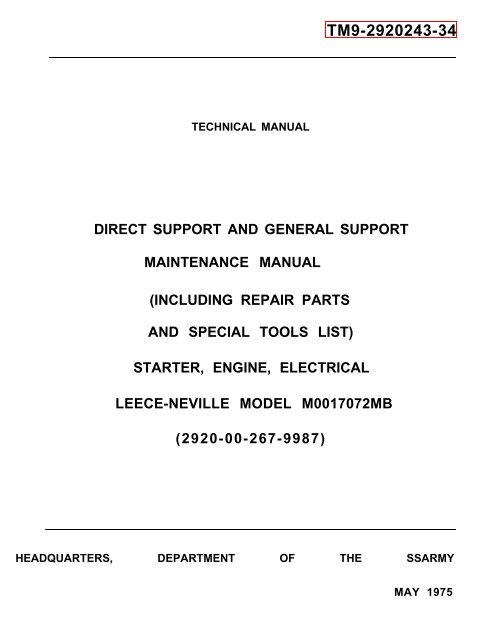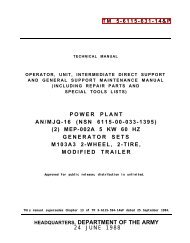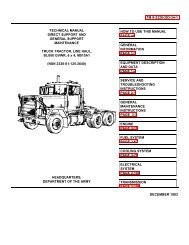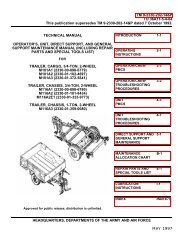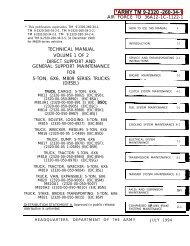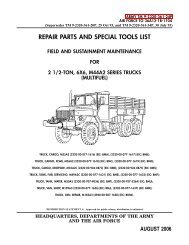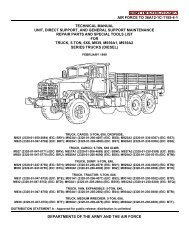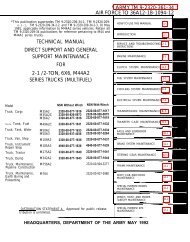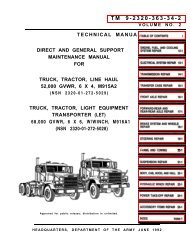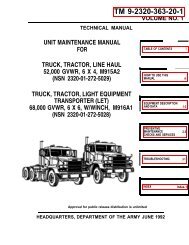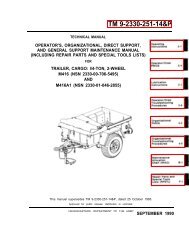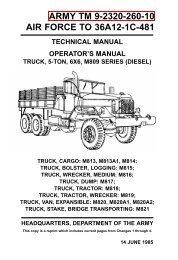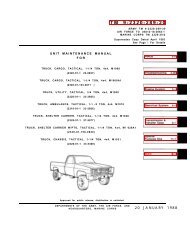TM 9-2920-243-34
TM 9-2920-243-34
TM 9-2920-243-34
Create successful ePaper yourself
Turn your PDF publications into a flip-book with our unique Google optimized e-Paper software.
<strong>TM</strong>9-<strong>2920</strong><strong>243</strong>-<strong>34</strong>TECHNICAL MANUALDIRECT SUPPORT AND GENERAL SUPPOR<strong>TM</strong>AINTENANCE MANUAL(INCLUDING REPAIR PARTSAND SPECIAL TOOLS LIST)STARTER, ENGINE, ELECTRICALLEECE-NEVILLE MODEL M0017072MB(<strong>2920</strong>-00-267-9987)HEADQUARTERS, DEPAR<strong>TM</strong>ENT OF THE SSARMYMAY 1975
<strong>TM</strong> 9-<strong>2920</strong>-<strong>243</strong>-<strong>34</strong>C1CHANGENO. 1HEADQUARTERSDEPAR<strong>TM</strong>ENT OF THE ARMYWashington, D.C., 19 September 1994DIRECT SUPPORT AND GENERAL SUPPOR<strong>TM</strong>AINTENANCE MANUAL(INCLUDING REPAIR PARTSAND SPECIAL TOOLS LIST)FORSTARTER, ENGINE, ELECTRICALLEECE-NEVILLE MODEL M0017072MB(<strong>2920</strong>-00-267-9987)<strong>TM</strong> 9-<strong>2920</strong>-<strong>243</strong>-<strong>34</strong>, dated 15 May 1975, is changed as follows:1. Remove old pages and insert new pages.2. New or changed material is indicated by a vertical bar in the margin of the page.Remove pagesInsert pages3-19 and 3-20 3-19 and 3-20Index-1 /(Index-2 blank)Index-1 /(Index-2 blank)3. File this change sheet in front of the publication for reference purposes.By Order of the Secretary of the Army:Official:GORDON R. SULLIVANGeneral, United States ArmyChief of StaffMILTON H. HAMILTONAdministrative Assistant to theSecretary of the ArmyDistribution:07543To be distributed in accordance with DA Form 12-38-E, (Block 0536) for <strong>TM</strong> 9-<strong>2920</strong>-<strong>243</strong>-<strong>34</strong>.Approved for public release: distribution is unlimited.
<strong>TM</strong> 9-<strong>2920</strong>-<strong>243</strong>-<strong>34</strong>T ECHNICAL M ANUALNo. 9-<strong>2920</strong>-<strong>243</strong>-<strong>34</strong>HEADQUARTERSDEPAR<strong>TM</strong>ENT OF THE ARMYWASHINGTON , DC, 15 May 1975DIRECT SUPPORT AND GENERALSUPPORT(INCLUDING REPAIRMAINTENANCE MANUALPARTS AND SPECIAL TOOLS LIST)STARTER,ENGINE, ELECTRICALLEECE-NEVILLE MODEL M0017072MB (<strong>2920</strong>-00-267-9987)Current as of 4 December 1974Paragraph PageCHAPTERSection1.I.II.INTRODUCTIONGeneral . . . . . . . . . . . . . . . . . . . . . . . . . . . . . . . . . . . . . . . . . . . . . . . . . . . . . .Description and data . . . . . . . . . . . . . . . . . . . . .1-11-41-11-1CHAPTERSection2.I.II.DIRECT SUPPORT AND GENERAL SUPPORT MAINTENANCERepair parts, special tools and equipment . . . . . . . . . . . . . . . . . . . .Troubleshooting . . . . . . . . . . . . . . . . . . . . . . . . . . . . . . . . . .INSTRUCTIONS2-12-52-12-1CHAPTERSection3.I.II.III.IV.v.REPAIR INSTRUCTIONSGeneral . . . . . . . . . . . . . . . . . . . . . . . . . . . . . . . . . . . . . . . . . . . . . . . . . . . . . .Disassembly . . . . . . . . . . . . . . . . . . . . . . . . . . . . . . . . . . . . . . . . .Assembly . . . . . . . . . . . . . . . . . . . . . . . . . . . . . . .Tests and adjustments . . . . . . . . . . . . . . . . . . .. . . . . . . . . . . . . . . . . . . . .Repair and rebuild standards . . . . . . . . . . . . . . . . . . . . . . . . . . . . . . . . . . .3-13-43-163-263-303-13-13-153-193-20APPENDIXA.REFERENCES . . . . . . . . . . . . . . . . . . . . . . . . . . . . . . .A-1B.I.II.III.IV.REPAIR PARTS AND SPECIAL TOOLS LIST . . . . . . . . . . . . . . .Introduction . . . . . . . . . . . . . . . . . . . . . . . . . . . . . . . . . . . . . . . . . . . .Repair parts list . . . . . . . . . . . . .. . . . . . . . . . . . . . . . . . . . . . .Special tools list . . . . . . . . . . . . . . . . . . . . . . . . . . . . . . . . . . . . . . . . . .National/NATO stock number and part number index . . . . . . . . . . ..B-1B-1B-4B-7B-11INDEXIndex-1*This manual supersedes <strong>TM</strong> 9-<strong>2920</strong>-<strong>243</strong>-<strong>34</strong>, 21 March 1972.i
<strong>TM</strong> 9-<strong>2920</strong>-<strong>243</strong>-<strong>34</strong>NumberLIST OF ILLUSTRATIONSTitleP a g e1-11-22-13-13-23-33-43-53-63-73-83-93-103-113-123-133-143-153-163-173-183-193-203-213-223-233-<strong>243</strong>-253-263-273-283-293-303-313-323-333-<strong>34</strong>3-353-363-373-383-393-403-413-423-433-44B-1B-2B-3Electrical engine starter assembly . . . . . . . . . . . . . . . . . . . . . . . . . . . . . . . . . . . . . . .Engine, electrical starter assembly-sectional view . . . . . . . . . . . . . . . . . . . . . . . . . . . . . . . . .Improvised brush spring lifter . . . . . . . . . . . . . . . . . . . . . . . . . . . . . . . . . . . . . . . . . . .Removing or installing jumper and lead assembly . . . . . . . . . . . . . . . . . . . . . . . . . . . . . . . . . . . . . .Removing or installing relay adjusting shaft access plug . . . . . . . . . . . . . . . . . . . . . . .Removing or installing relay assembly attaching parts . . . . . . . . . . . . . . . . . . . . . . . . . . . . .Disconnecting or connecting relay adjusting shaft using shaft adjusting tool . . . . . . . . . . . . . . . . . . . . . . .Removing or installing pinion housing assembly attaching parts . . . . . . . . . . . . . . . . . . . . . . . . . . . . . . . .Removing or installing pinion housing and related parts . . . . . . . . . . . . . . . . . . . . . . .Removing or installing pinion housing oil wick . . . . . . . . . . . . . . . . . . . . . . . . . . . . . . . . . . . . . . . . . . . . . . . . . . .Removing or installing lever shaft retaining screw and washer . . . . . . . . . . . . . . . . . . . . . . . . . . . . . . .Removing or installing lever shaft . . . . . . . . . . . . . . . . . . . . . . . . . . . . . . . . . . . . . . . . . . . . . . . .Removing or installing shaft housing assembly attaching parts . . . . . . . . . . . . . . . . . . . . . . . . . . . . . . . . . . . .Removing or installing drive and shaft and lever assemblies . . . . . . . . . . . . . . . . . . . . . . . . . . . . . . . .Removing or installing drive clutch thrust washers . . . . . . . . . . . . . . . . . . . . . . . . . . . . . . .Disassembling or assembling shaft and lever assembly . . . . . . . . . . . . . . . . . . . . . . . . . . . . . . . . . . . . . . . . . . .Removing or installing shift housing packages and oil wick . . . . . . . . . . . . . . . . . . . . . . . . . . . . . . . . . . . . . . . .Removing or installing armature . . . . . . . . . . . . . . . . . . . . . . . . . . . . . . . . . . . . . . . . . . . . . . . . . . . . . . . . . . . . .Removing or installing armature thrust washers . . . . . . . . . . . . . . . . . . . . . . . . . . . . . . . . . . . . . . . . . . . . . . . . .Removing or installing brush opening band . . . . . . . . . . . . . . . . . . . . . . . . . . . . . . . . . . . . .Disconnecting or connecting brushes . . . . . . . . . . . . . . . . . . . . . . . . . . . . . . . . . . . .Removing or installing brushes in brush rigging using improvised spring lifter . . . . . . . . . . . . . . . . . . . . .Removing or installing brush rigging assembly attaching parts . . . . . . . . . . . . . . . . . . . . . . . . . . .. . .Removing or installing brush rigging . . . . . . . . . . . . . . . . . . . . . . . . . . . . . . . . . . . . . . . . . . . .Removing or installing brush spring holders . . . . . . . . . . . . . . . . . . . . . . . . . . . . . . . . . . . . . . . . . .Removing or installing brush rigging jumper screw and attaching parts . . . . . . . . . . . . . . . . . . . . . . . . . . . . .Disassembling or assembling commutator end housing assembly . . . . . . . . . . . . . . . . . . . . . . . . . . . . . . . . . . .Testing field coils for grounds . . . . . . . . . . . . . . . . . . . . . . . . . . . . . . . . . . . . . . . . .Testing armature for grounds . . . . . . . . . . . . . . . . . . . . . . . . . . . . . . . . . . . . . . . .Testing armature for short circuits . . . . . . . . . . . . . . . . . . . . . . . . . . . . . . . . . . . . . . . .Checking armature eccentricity . . . . . . . . . . . . . . . . . . . . . . . . . . . . . . . . . . . . .Removing or installing bearing in pinion housing . . . . . . . . . . . . . . . . . . . . . . . . . . . . .Removing or installing bearing in shift position . . . . . . . . . . . . . . . . . . . . . . . . . . . . . . .Removing or installing bearing in commutator end housing . . . . . . . . . . . . . . . . . . . . . . . . . . .Cutting tool sharpening dimensions . . . . . . . . . . . . . . . . . . . . . . . . . . . . . . . . . . . . . . .Proper position of cutting tool . . . . . . . . . . . . . . . . . . . . . . . . . . . . . . . . . . . . . .Polishing armature commutator with sandpaper . . . . . . . . . . . . . . . . . . . . . . . . . . . . . . . . . . . . . . . . . . . .Positioning jumper or brush riggin assembly . . . . . . . . . . . . . . . . . . . . . . . . . . . . . . . . . . . . . . . . . . . . . . . . . . . . .Positioning sandpaper or armature . . . . . . . . . . . . . . . . . . . . . . . . . . . . . . . . . . . . . . . . . . . . . . . . . . . . . . . . . . . . . .Rotating armature to seat brushes . . . . . . . . . . . . . . . . . . . . . . . . . . . . . . . . . .Examples of satisfactory and unsatisfactory brush seats . . . . . . . . . . . . . . . . . . . . . . . . . . . . . . . . . . . .Measuring armature end play. . . . . . . . . . . . . . . . . . . . . . . . . . . . . . . . . . . . . . . .Pinion housing position for LDS-465-l, LDS-465-lA and MACK Model ENDT 673 engine application . . . . . . . . . .Pinion housing position for LD-465-l, LD465-lC and LDT-465-lC engine application . . . . . . . .Pinion housing position for LDS-465-2 engine application . . . . . . . . . . . . . . . . . . . . . . . . . . . . . . . . . . . .Measuring drive clutch pinion clearance . . . . . . . . . . . . . . . . . . . . . . . . . . . . . . . . . . . . . . .Starter test setup . . . . . . . . . . . . . . . . . . . . . . . . . . . . . . . . . . . . . . . . . . . . . . . . . . . . . . . .Electrical engine starter assembly . . . . . . . . . . . . . . . . . . . . . . . . . . . . . . . . . . . . . . .Starter assembly -exploded view.. . . . . . . . . . . . . . . . . . . . . . . . . . . . . . . . . . . . . . . .Special tool . . . . . . . . . . . . . . . . . . . . . . . . . . . . . . . . . . . . . . . . . . . . . .1-21-32-13-13-23-23-23-23-33-33-33-43-43-43-43-53-53-63-63-63-63-73-73-83-83-93-93-103-113-113-123-123-133-133-143-143-153-163-163-163-173-173-183-183-183-193-20B-4B-5B-6ii
<strong>TM</strong> 9-<strong>2920</strong>-<strong>243</strong>-<strong>34</strong>CHAPTER 1INTRODUCTIONSection I. GENERAL1-1. ScopeThis manual is for your useElectrical Engine StarterNeville Model M0017072MB(fig. 1-1).in maintaining theAssembly, Leece-(<strong>2920</strong>-00-267-9987)1-2. Maintenance Forms and RecordsMaintenance forms and records that you arerequired to use are explained in <strong>TM</strong> 38-750.1-3. Reporting of ErrorsYou can improve this manual by calling attentionto errors and by recommending improvementsusing DA Form 2028 (Recommended Changes toPublications and Blank Forms) or by a letter andmail direct to Commander, US Army Tank-Automotive Command, ATTN: AMSTA-MSP,Warren, MI 48090. A reply will be furnisheddirect to you.Section Il. DESCRIPTION AND DATA1-4. DescriptionThis electrical starter is a heavy duty, 24-volt,insulated, waterproof, fungus and corrosionresistant, solenoid operated, enclosed shift -levertype with eight brushes retained in four brushholders. The drive assembly is a heavy duty,overrunning type and the pinion clearance isadjustable. The starter assembly consists of eightmajor components, These are the brush riggingassembly, shift housing assembly, shaft and leverassembly, pinion housing assembly, driveassembly, armature assembly, and field ringassembly.1-5. Tabulated DataVoltage . . . . . . . . . . . . . . . . . . . . . . . . . . . . . . . . . . . . . . . . . ..24vdcCurrent at rated load (rated max) . . . . . . . .500 ampsHorsepower (rated) 8.5 hp at 2550 rpmStall torque . . . . . . . . . . . . . . . . . . . . . . . . . .106 lbs-ftPinion rotation (facing drive end) . . . . . . . clockwiseNumber of pinion teeth(one tooth blank) . . . . . . . . . . . . . . . . . . . . . . . . . . . . . . . . . . . .12Mounting data:Number of mounting holes . . . . . . . . . . . . . . . . . . . . . . . . . . .3Diameter of mounting holes . . . . . . . . . . . . . . . . . . . . 0.656 in.Mounting holes circle diameter . . . . . . . . . . . . . . . . . 5.75 in.Length . . . . . . . . . . . . . . . . . . . . . . . . . . . . . 18.72 in.Height . . . . . . . . . . . . . . . . . . . . . . . . . . . . . . . . . . . . . . .9.<strong>34</strong> in.Diameter (field ring) . . . . . . . . . . . . . . . . . . . . . . . . . . . . . .5.12 in.Weight . . . . . . . . . . . . . . . . . . . . . . . . . . . . . . . . . . . . . . . . . .63 lbs1-1
<strong>TM</strong> 9-<strong>2920</strong>-<strong>243</strong>-<strong>34</strong>Figure 1-1. Electrical engine starter assembly.1-2
<strong>TM</strong> 9-<strong>2920</strong>-<strong>243</strong>-<strong>34</strong>A - Fiber thrust washerB - Steel thrust washerC - Preformed packingD - BrushE - Solenoid relay assemblyF - Preformed packingG - Switch shaft sealH - Field coilsJ - Steel thrust washerK - Fiber thrust washerL - Shift housing bushing-type bearingM - Fiber washerN - Shift housingP - Shaft and lever assemblyQ - Preformed packingR - Pinion housingS - Oil wickT - Pinion housing bushing-type bearingU - Drive assemblyV - Armature oil sealW - Field ringX - ArmatureY - Brush opening bandZ - Commutator end housingAA - Brush holder and spring assemblyBB - Commutator end housing bushing-type bearingFigure 1-2. Engine electrical starter assembly - sectional view.1-3
<strong>TM</strong> 9-<strong>2920</strong>-<strong>243</strong>-<strong>34</strong>CHAPTER 2DIRECT SUPPORT AND GENERAL SUPPOR<strong>TM</strong>AINTENANCE INSTRUCTIONSSection I. REPAIR PARTS, SPECIAL TOOLS AND EQUIPMENT2-1. Tools and EquipmentStandard and commonly used tools and equipmenthaving general application to this materielare authorized for issue by Tables of Allowance(TA) and Tables of Organization and Equipment(TOE).2-2. Special Tools and EquipmentSpecial tools and equipment required to performrepair and rebuild operations contained in thismanual are listed in appendix B.2-3. Repair PartsRepair parts for the starter assembly are listed inappendix B which is the authority forrequisitioning replacements.2-4. Improvised ToolsThe dimensional detail drawing of the improvisedbrush spring lifter (fig. 2-1) applies only to directand general support shops to enable thesemaintenance organizations to fabricate the toolslocally, if desired. This tool is of chief value tomaintenance organizations engaged in rebuildinga large number of identical components; however,it is not essential for rebuild and is not availablefor issue.Figure 2-1. Improvised brush spring lifter.Section Il. TROUBLESHOOTING2-5. Generala. This section contains troubleshooting informationfor locating and correcting most of theoperating troubles which may develop in thestarter. Each malfunction for an individualcomponent is followed by a list of tests or inspectionswhich will help you to determineprobable causes and corrective actions to take.You should perform the tests/inspections andcorrective actions in the order listed.b. This manual cannot list all malfunctions thatmay occur, nor all tests or inspections andcorrective actions. If a malfunction is not listed oris not corrected by listed corrective actions, notifyyour supervisor.c. Troubleshooting a disabled starter after ithas been removed from the vehicle and/or engineconsists of subjecting it to tests on a suitable teststand. Information pertaining to this testing iscontained in paragraphs 3-26 through 3-29.2-6. ProceduresAfter the starter has been received by themaintenance activity for preliminary inspection,or if performance of the starter has been unsatisfactorydue to unknown causes, it must beinspected as described in this section. When thecause for failure has been found, the startershould be disassembled and repaired beforeproceeding with the tests. Additional operationaltests performed on a damaged starter would onlyincrease the damage. The following chart lists thecommon malfunctions that might be encountered,their probable causes, and the recommendedcorrective action.NOTEMake certain that unusual noises are notproduced by the test equipment used.2-1
<strong>TM</strong> 9-<strong>2920</strong>-<strong>243</strong>-<strong>34</strong>Table 2-1. TroubleshootingMalfunctionTest or InspectionCorrective ActionSTARTER1. Starter Fails to Crank.Step 1. Check to see if starter is frozen.Disassemble starter (para 3-4 through 3-12) and check for cause (para 3-14).Step 2. Check to see if current is reaching starter by connecting a voltmeter between starter terminal and ground. Energisestarter and observe voltmeter. A reading of approximately 24 volts should be indicated.If no reading is noted, trace out starter circuit and check battery condition. (Refer to pertinentoperator/organizational manual).Step 3. Check to see if solenoid relay is defective by placing a jumper across battery terminal and relay terminal.If relay does not operate, remove relay (para 3-5) and install new relay (para 3-25).Step 4. Remove brush opening band (para 3-11a ), and check for poor brush spring tension and worn brushes (para 3-14e ).This condition is usually indicated by a slight voltage drop at starter terminal.If brushes are worn or spring tension is poor, replace brushes and/or springs as necessary and install band(para 3-20).Step 5. Check for worn or pitted commutator. This condition may show a slight voltage drop when the starter is energizeddepending upon the extent of the damage.Disassemble starter (para 3-4 through 3-12), resurface commutator (para 3-15e ), and assemble starter (para 3-16 through 3-25).2. Low Speed and Low Current.Step 1. Check for high internal resistance.Remove brush opening band (para 3-11a ) and tighten brush leads. Install band (para 3-20f ).Step 2. Check for poor brush contact by removing brush opening band (para 3-1 la ) and inspecting commutator (para 3-14g )for worn or dirty condition.If commutator is worn or dirty, disassemble starter (para 3-4 through 3-12), resurface commutator (para 3-15e ), and assemble starter (para 3-16 through 3-25). Check for worn brushes (para 3-14e ).3. Low Speed and High Current.Step 1. Check to see if the armature is faulty due to excessive brush arcing.If brush arcing is apparent, disassemble starter (para 3-4 through 3-12), check armature for grounds or shorts(para 3-14g ). Replace starter if armature is grounded.Step 2. Check for armature drag by disassembling starter (para 3-3 through 3-12), inspect bearings and armature (para 3-14bc, g and h).Repair armature (para 3-15e ), and/or replace bearings as necessary, and assemble starter (para 3-16 through3-25).4. Starter Produces Excessive Noise.Step 1. Inspect bearings for lack of lubrication.Lubricate bearings (para 3-17).Step 2. Check for worn bearings by disassembling starter (para 3-4 through 3-12), and inspecting the bearings (para 3-14b,c, and h ).Replace bearings, if necessary, and assemble starter (para 3-16 through 3-25).Step 3. Inspect for loose pole shoes.Tighten pole shoe screws.5. Starter Fails to Crank or Operates Very Slowly.Step 1. Check to see if armature shows excessive brush arcing, disassemble starter (para 3-4 through 3-12), check armaturefor grounds or shorts (para 3-14g ).Replace starter if armature is grounded.Step 2. Check for worn, binding, or poorly seated brushes by removing brush opening band (para 3-1 la ), and checking brushspring tension (para 3- 14e ) and brush condition.Replace springs and/or brushes as necessary and install band (para 3-20f ).Step 3. Check for poor commutation due to dirty, rough, or pitted commutator.Disassemble starter (para 3-4 through 3-12, resurface commutator (para 3-15e ), and assemble starter (pars 3-16 through 3-25).Step 4. Check for eccentric commutator (out of round) by disassembling starter (para 3-4 through 3-12) and checkingeccentricity (para 3-14g ).Step 5. Inspect field coils to see if they are grounded (para 3-14f ).If field coils are grounded, replace starter.6. Excessive Arcing of Brushes.Step 1. Remove brush opening band (para 3-1 la ) and check for worn, binding or broken brushes or defective springs (para 3-14e ).Replace brushes and/or springs as necessary and install band (para 3-20f ).Step 2. Check for scored, pitted or dirty commutator.Disassemble starter (para 3-4 through 3-12), resurface commutator (para 3-15e ), and assemble starter (para 3-16 through 3-25).2-2
<strong>TM</strong> 9-<strong>2920</strong>-<strong>243</strong>-<strong>34</strong>Table 2-1. Troubleshooting-ContinuedMalfunctionTest or InspectionCorrective ActionSTARTER-ContinuedStep 3. Check for eccentric commutator (out of round) by disassembling starter (para 3-4 through 3-12) and checkingeccentricity (para 3-14g).Repair commutator (para 3-15e), if possible, and assemble starter (para 3-16 through 3-25).Step 4. Inspect field coils for shorts or grounds (para 3-14f).If field coils are grounded, replace starter.Step 5. If armature shows excessive brush arcing, disassemble starter (para 3-4 through 3-12) check armature for grounds orshorts (para 3-14g).Replace starter if armature is grounded.7. Starter Drive Fails to Engage.Step 1. Check operation of solenoid relay by placing a jumper across battery terminal and solenoid relay terminal. Thisshould cause the relay to operate.If the relay does not operate, remove relay (para 3-5) and install new relay (para 3-25).Step 2. Check to see if solenoid relay linkage is adjusted properly (para 3-25f).If adjustment is incorrect, remove solenoid relay adjusting plug and adjust linkage (para 3-25f).Step 3. Check for binding in shift lever or drive assembly by partially disassembling starter (para 3-5, 3-6 and 3-7). Inspectlever (para 3-14i) and drive assembly (para 3-14d) for defective parts.Replace defective parts and assemble starter (para 3-23, 3-24 and 3-25).8. Starter Vibrates During Operation.Check for worn or damaged bearings by disassembling starter (para 3-4 through 3-12), inspect bearings (para 3-14b, c, andh).Replace bearings if necessary and assemble starter (para 3-16 through 3-25).9. Drive Assembly Pinion Will Not Override.Check for defective drive by disassembling starter (para 3-4 through 3-12) and inspecting drive assembly.Replace drive assembly, if necessary, and assemble starter (para 3-16 through 3-25).2-3
<strong>TM</strong> 9-<strong>2920</strong>-<strong>243</strong>-<strong>34</strong>CHAPTER 3REPAIR INSTRUCTIONSSection I. GENERAL3-1. Removal and Installation Before beginning disassembly, wash starterFor instructions covering removal and in- exterior thoroughly with drycleaning solventstallation of the starter, refer to <strong>TM</strong> 9-2320-211- Type II (SD-2), Federal Specification P-D-68020 for LDS-465-1, and LDS-465-1A and MACK and dry with compressed air (15 psi).Model ENDT 673 engines, <strong>TM</strong> 9-2320-209-20 for 3-3. Parts KitLD-465-1, LD-465-1C and LDT-465-1C engines,Standard parts kits should always be used whenand <strong>TM</strong> 9-2320-230-20 for the LDS-465-2 engine.repairing or rebuilding starter assembly. Refer to3-2. Cleaning Before Disassembly Appendix B for description of parts kits.Section Il. DISASSEMBLY3-4. Generala. Disassembly of starter will be performed asillustrated in the following figures and instructions.Sequence of disassembly steps areshown in alphabetical order on each illustration.b. All packings and gaskets will be discardedduring disassembly and new parts installedduring assembly.3-5. Removal of Solenoid Relaya. Remove in following sequence: two hex nuts(A, fig. 3-1) and jumper (B); two hex nuts (C) andlockwashers (D); hex nut (E); and lead assembly(F).b. Remove adjusting shaft access plug (fig. 3-2).c. Remove two hex-head bolts (A, fig. 3-3)securing relay assembly (B) to field ringassembly.d. Insert shaft adjusting tool (A, fig. 3-4)through access opening in relay cover. Engageend of tool with adjusting shaft and turn toolcounterclockwise (B) until relay is free of plunger.Remove relay assembly (C).Figure 3-1. Removing or installing jumper and lead assembly.3-1
<strong>TM</strong> 9-<strong>2920</strong>-<strong>243</strong>-<strong>34</strong>(2) Remove pinion housing (A, fig. 3-6), fromstarter and then remove and discard packing (B).Remove thrust washer (C) from armature shaft.Figure 3-4. Disconnecting or connecting relay adjusting shaftusing shaft adjusting tool.Figure 3-2. Removing or installing relay adjusting shaftaccess plug.Figure 3-3. Removing or installing relay assemblyattaching parts.3-6. Removal and Disassembly of Pinion HousingAssemblya. Removal.(1) Scribe alinement marks (A, fig. 3-5) onshift housing and pinion housing (C) for properpositioning of pinion housing during assembly.Remove six hex-socket head screws (B). Taparound edges of pinion housing (C) to loosenhousing pilot from its bore in shaft housing.Figure 3-5. Removing or installing pinion housing assemblyattaching parts.3-2
<strong>TM</strong> 9-<strong>2920</strong>-<strong>243</strong>-<strong>34</strong>Figure 3-6. Removing or installing pinion housing andrelated parts.b. Disassembly. Remove hex-socket head plug(A, fig. 3-7) and oil wick (B) from pinion housing.Remove six seal plugs (C) from housing. Do notattempt to remove bushing-type bearing since itshould not be replaced unless it fails to meetinspection requirements (para 3-14b).3-7. Removal of Shift Housing Assemblya. Remove hex-socket head screw (A, fig. 3-8)and flat washer (B).b. Thread hex-socket head screw (A, fig. 3-9)into lever shaft (B) and pull shaft from shifthousing. Remove screw and packing (C) fromshaft.c. Scribe an alinement (A, fig. 3-10) on shafthousing assembly (D) and field ring. Remove sixhex-socket head screws (B) andSlide shift housing assemblyposition shown in figure 3-11.lockwashers (C).(D) forward toFigure 3-7. Removing or installing pinion housing oil wick.Figure 3-8. Removing or installing lever shaft retaining screwand washer.3-3
<strong>TM</strong> 9-<strong>2920</strong>-<strong>243</strong>-<strong>34</strong>e. Remove two fiber thrust washers (A, fig. 3-12), shift housing assembly (B), fiber washer (C),and steel thrust washer (D) from armature shaft.Figure 3-11. Removing or installing drive and lever assemblies.Figure 3-9. Removing or installing lever shaft.Figure 3-12. Removing or installing drive clutch thrust washers.Figure 3-10. Removing or installing shaft housing assemblyattaching parts.d. Slide drive assembly (A, fig. 3-11) out ofshift housing assembly and guide shaft and leverassembly (B) down and out of housing at thesame time.3-8. Shaft and Lever Assembly(Fig. 3-13)Press out roll pins (A and C) to separate shaft andinsert assembly (B) and coupling (D) from leverarm assembly.NOTEShaft and lever assembly should not bedisassembled unless inspection (para 3-14) indicates need for replacing one ofcomponents.3-4
<strong>TM</strong> 9-<strong>2920</strong>-<strong>243</strong>-<strong>34</strong>Figure 3-13. Disassembling or assembling shaftand lever assembly.3-9. Shift Housing Assembly(Fig. 3-14)Remove and discard packing (A and B). Removehex-socket head plug (C) and oil wick (D).NOTEDo not attempt to remove bushing-typebearing unless inspection (para 3-14c)indicates for replacement.Figure 3-14. Removing or installing shift housing packingsand oil wick.3-10. Removal of Armature AssemblyRemove armature assembly from field ringassembly as shown in figure 3-15. Remove fiberthrust washer (A, fig. 3-16) and steel thrustwasher (B) from armature.NOTEThe fit of thrust washer (B, fig. 3-16) canvary from a slip to a press fit. It may benecessary to press washer off armatureshaft.3-5
<strong>TM</strong> 9-<strong>2920</strong>-<strong>243</strong>-<strong>34</strong>Figure 3-15. Removing or installing armature.Figure 3-17. Removing or installing brush opening band.Figure 3-16. Removing or installing armature thrust washers.3-11. Removal of Brush Rigging Assemblya. Remove two square nuts (A, fig. 3-17), tworound-head screws (B), brush opening band (C),and band (D).b. Remove two cross-recessed head screws (A,fig. 3-18) and one lock plate (B) from each of fourbrush attaching locations.Figure 3-18. Disconnecting or connecting brushes.3-6
<strong>TM</strong> 9-<strong>2920</strong>-<strong>243</strong>-<strong>34</strong>c. Using an improvised brush spring lifter (A,fig. 3-19) pull the brush spring (B) out of the wayand slide brush (C) out of its holder. Removeremaining seven brushes in same manner. (Seeparagraph 2-4 for instructions to make, andauthorization for use of, the improvised brushspring lifter).d. Scribe an alinement mark (A, fig. 3-20) onend housing and field ring. Remove four hex-headscrews (B) and lock washers (C). Pull brushrigging assembly (D) out of field ring assembly.NOTEIt may be necessary to tap around edge ofhousing with a soft hammer to loosenpacking seal effect.Figure 3-20. Removing or installing brush rigging assemblyattaching parts.Figure 3-19. Removing or installing brushes in brush riggingusing improvised brush spring lifter.3-12. Brush Rigging Assemblya. Remove brush holder jumper (A, fig. 3-21)and packing (B). Discard packing.NOTEBrush holder jumper (A) may fall loose infield ring assembly when removing brushrigging assembly.3-7
<strong>TM</strong> 9-<strong>2920</strong>-<strong>243</strong>-<strong>34</strong>b. Remove one cross-recessed head screw (A,fig. 3-22), one double-coil lockwasher (B), and oneinsulating washer (C), at each of four brush holdersupports. Remove and separate the four brushholder and spring assemblies (D), twelve insulatingwashers (E), and insulating bushing (F).Figure 3-21. Removing or installing brush rigging.Figure 3-22. Removing or installing brush spring holders.3-8
<strong>TM</strong> 9-<strong>2920</strong>-<strong>243</strong>-<strong>34</strong>c, Remove two guard washers (A, fig. 3-23) andinsulating bushing (B) from jumper screw (C).Slide jumper screw out of commutator endhousing and then remove insulating bushing (D)and sealing ring (E).d. Remove three flat head screws (A, fig. 3-24)cover plate (B), and plate gasket (C). Discardgasket. Remove two hex-socket head plugs (D)and oil wick (E).NOTEDo not attempt to remove bushing-typebearing unless inspection (para 3-14 h)indicates need for replacement.Figure 3-23. Removing or installing brush rigging jumperscrew and attaching parts.Figure 3-24. Disassembling or assembly commutator endhousing assembly.3-13. CleaningWARNINGParticles blown by compressed air arehazardous. Make certain air stream isdirected away from user and any otherpersons in area.a. General. Wash all parts, except thosedetailed in 3-13 b through 3-13f below, in drycleaningsolvent, Type II (SD-2), Specification P-D-680, and dry with compressed air.b. Field Coils. Clean field coils and field ringthoroughly with a cloth dampened with drycleaningsolvent. Be careful not to damageprotective insulation coating. Dry thoroughlywith compressed air (15 psi max.).c. Armature. Remove loose particles fromarmature and wipe with a clean cloth dampenedwith dry-cleaning solvent. Clean commutatorlightly with 00 sandpaper and remove all dustwith compressed air.d. Brushes. Clean brushes with a clean, drycloth only. Extreme care must be taken toprevent dry-cleaning solvent from contactingbrushes.e. Relay Coil and Shell Assembly. Only externalmetal surfaces of relay coil and shellassembly can be cleaned. Clean with a clothdampened in dry-cleaning solvent.f. Non-Metallic Components. Do not clean suchparts as sealing rings, insulating bushings, andinsulating washers. Wipe with a clean, dry cloth.3-14. Inspectiona. General. Inspect all screws, bolts, nuts,threaded holes, and plugs for worn or damagedthreads. Replace all worn or damaged parts.Inspect remaining hardware items and replacedamaged parts.b. Pinion Housing.(1) Inspect pinion housing for cracks,distortion, and burs. Replace if damaged.(2) Inspect housing bushing-type bearing forscore marks and wear patterns. Check bearingagainst limits specified in repair and rebuildstandards (para 3-31 d) and replace (para 3-15 b ),if worn beyond limits.(3) If housing bushing-type bearing isremoved (para 3-15 b ), check diameter of bearingbore in pinion housing against limits specified inrepair and rebuild standards (para 3-31d).Replace housing if worn beyond limits.3-9
<strong>TM</strong> 9-<strong>2920</strong>-<strong>243</strong>-<strong>34</strong>c. Shift Housing Assembly.(1) Inspect shift housing for cracks ordistortion and burs on mating flange and packingsurfaces. Replace if damaged.(2) Inspect bushing-type bearing for scoremarks and wear patterns. Check bearing againstlimits specified in repair rebuild standards (para3-31e) and replace (para 3-15c) if worn beyondlimits.(3) If the bushing.type bearing is removedfrom the shift housing, check diameter of bearingbore against limits specified in repair and rebuildstandards (para 3-31e). Replace shift housing ifworn beyond limits.d. Drive Assembly.(1) Inspect bearing surface and driveassembly internal splines for score marks andwear patterns. Replace drive if worn or damaged.(2) Check drive spring against limitsspecified in repair and rebuild standards (para 3-31a) and replace spring if it is not within theselimits.(3) Inspect drive collar for signs of wear anddistortion and replace drive assembly if eithercondition exists.(4) Inspect gear teeth for wear pattern andreplace drive assembly if wear is excessive.e. Brush Holder Assemblies and Brushes.(1) Inspect brush holder and springassemblies for any visible damage. Replace ifdamaged. Check brush spring tension with a 0 to40 ounce spring scale. It should require approximately36 ounces to lift end of spring out ofbrush holder. If tension is less than 30 ounces,replace holder and spring assembly.(2) Inspect brushes for chips, cracks, looseterminal leads, and grease spots. Check length ofbrushes against limits specified in repair andrebuild standards (para 3-31a.). Replace brushesif worn beyond these limits.f. Field Ring Assembly.(1) Check field coils for insulation breakdownwith an ohmmeter. Attach one probe of ohmmeterto field coil terminal and the other probe to fieldring (fig. 3-25). The minimum reading should notbe less than one megohm. If field coils aredamaged, replace starter.(2) Inspect field frame for cracks and burs.Replace starter if cracked.Figure 3-25. Testing field coils for grounds.g. Armature Assembly.(1) Inspect commutator contact surface ofarmature. A satisfactory condition is indicated byan even, highly burnished, dark-copper color. Ifcontact surface is rough, pitted, scored, burned,or coated with hard carbon or oil, commutatormust be cleaned or resurfaced as necessary,provided it is in good electrical and mechanicalcondition as a result of following inspection.Check armature against limits specified in repairand rebuild standards (para 3-31 a) and replacestarter if it is not within these limits. Inspectsplines of armature shaft for wear or damage andreplace starter if either condition exists.(2) Inspect armature for grounds with a testlight by touching one probe to commutator barriser and other to armature core (fig. 3-26). Testall commutator bars in this manner. If test lightglows, armature is grounded and starter must bereplaced.(3) Inspect armature for short circuits with agrowler. Place armature in growler and hold athin strip of steel, such as a hacksaw blade, about1/32 to 1/16-inch away from armature core asshown in figure 3-27. While holding steel strip inposition, rotate armature slowly in growler. Ashort circuit will pull the steep strip tightlyagainst armature core and cause strip to vibrate.If a short circuit is found, starter must bereplaced.3-10
<strong>TM</strong> 9-<strong>2920</strong>-<strong>243</strong>-<strong>34</strong>(4) Inspect armature shaft alinement andcommutator for eccentricity to shaft with a latheor V-blocks and a dial indicator (fig. 3-28). Checkarmature shaft for true alinement. If shaft runoutexceeds 0.005-inch, commutator of armatureshaft must be resurfaced provided it will not becut below limits specified in repair and rebuildstandards (para 3-31 a). If commutator requirescutting below limits specified, replace starter.Figure 3-27. Testing armature for short circuits.Figure 3-26. Testing armature for grounds.3-11
<strong>TM</strong> 9-<strong>2920</strong>-<strong>243</strong>-<strong>34</strong>not meet allowable wear limits, remove it asshown in figure 3-29 and replace it with a newbearing. Press new bearing into position. Drillbushing oil hole using a 21/64-inch diameter drilland oil wick bore as a pilot. Ream bearing to adiameter of 0.750 ± 0.001-inch.Figure 3-28. Checking armature eccentricity.h. Commutator End Housing Assembly.(1) Inspect commutator end head for cracks,distortion, and burs. Replace if damaged.(2) Inspect bushing-type bearing for scoremarks and wear patterns. Check bearing againstlimits specified in repair and rebuild standards(para 3-31c) and replace if worn beyond limits.(3) If head bushing-type bearing is removed,check diameter of bearing bore in commutator endhead against limits specified in repair and rebuildstandards (para 3-31c). Replace head if it is notwithin these limits.i. Shaft and Lever Assembly.(1) Inspect shaft for wear on shaft or burs inpacking area. Replace shaft if worn or damaged.Examine nylon insert in threaded portion of shaftand replace if damaged or worn beyondusefulness. Check against limits specified inrepair and rebuild standards (para 3-31b) andreplace if parts are beyond these limits.(2) Inspect lever for wear on slider blocks.Replace lever if wear exists.3-15. Repaira. General. The following subparagraphs coveronly those parts wherein a repair operation willreturn damaged part to serviceable condition.Parts not detailed herein must be replaced whenthey fail to pass the required inspection (para 3-14).b. Pinion Housing. Smooth minor burs ordamage on mating surfaces of pinion housingwith a fine mill file. If bushing-type bearing didFigure 3-29. Removing or installing bearing in pinion housing.c. Shift Housing Assembly.(1) Smooth minor damage such as nicks,burs, etc., on mating surfaces of housing with afine mill file.(2) If bushing-type bearing did not meetallowable wear limits, remove the old bearing asshown in figure 3-30. When installing a newbearing, reposition housing with opposite side upfrom that shown in figure 3-30 and press bearingin flush with housing bore. Drill bushing oil holeusing a 21/64-inch diameter drill and oil wick boreas a pilot. Ream bearing to a diameter of 0.875±0.001-inch.NOTEBearing can be pressed flush more easilyif a 1-inch arbor is used. This will notallow bearing to be pressed below surface.3-12
<strong>TM</strong> 9-<strong>2920</strong>-<strong>243</strong>-<strong>34</strong>Figure 3-31. Removing or installing bearing in commutatorend housing.Figure 3-30. Removing or installing bearing in shift housing.d. Commutator End Housing Assembly.(1) Smooth minor damage such as nicks,burs, etc., on mating surface of housing with afine mill file.(2) If bushing-type bearing did not meetallowable wear limits, remove old bearing asshown in figure 3-31. Install a new bearing in thesame manner. It should be pressed in so that it isflush with housing bore. Drill bushing oil holeusing a 21/64-inch diameter drill and oil wick boreas a pilot. Ream bearing to a diameter of 0.730±0.001-inch.NOTEBearing can be pressed flush more easilyif a 15/16-inch arbor is used. This will notallow bearing to be pressed below surface.e. Armature.(1) Resurfacing. Sharpen lathe cutting tool todimensions given in figure 3-32. For commutatorturning, lathe cutting tool must be extremelysharp. After grinding, hone tool with a fine hardstone to insure a smooth cut during turningoperation.Position tool with respect to commutator asshown in figure 3-33. Resurface commutator at800 rpm taking only light cuts each time. No morethan 0.005-inch should be removed during anyone cut and the final cut should not be more than0.002-inch. After resurfacing, check commutatoragainst limits specified in repair and rebuildstandards (para 3-31) and replace it if it fallsbelow these limits.NOTEWhen a cut is started, it should be carriedacross entire surface without stopping.3-13
<strong>TM</strong> 9-<strong>2920</strong>-<strong>243</strong>-<strong>34</strong>NOTEThe armature used in this starter is aflush mica design and the undercuttingoperation normally performed afterresurfacing is not required.Figure 3-32. Cutting tool sharpening dimensions.(2) Polishing commutator. Remove all copperand mica particles with compressed air. Polishcommutator in a lathe with 2/0 sandpaper asillustrated in figure 3-<strong>34</strong>, with armature rotatingat 1500 rpm.(3) Checking armature eccentricity. Set up adial indicator gage and measure the runout of thecommutator (fig. 3-28). Total runout should notexceed 0.003-inch.Figure 3-33. Proper position of cutting tool.3-14
<strong>TM</strong> 9-<strong>2920</strong>-<strong>243</strong>-<strong>34</strong>Figure 3-<strong>34</strong>. Polishing armature commutator with sandpaper.Section III.ASSEMBLY3-16. Generala. Instructions covering assembly of the starterare almost identically the reverse of thosecovering disassembly. Therefore, the followingassembly procedures, for the most part, will bereferenced to paragraphs appearing in section II.When this occurs, instructions appearing witheach referenced paragraph should be performed inreverse order from which they are given.For example, if reference is made to paragraph 3-12 then disassembly subparagraphs a throughdand any instructions contained therein alsoshould be performed in reverse order. Throughoutassembly procedure, it will be assumed that thereferenced disassembly instructions must beperformed in reverse order to accomplish theassembly procedure.b. Figure B-2 in appendix B of the manualprovides a visual reference to relationship ofcomponents of starter and for parts identification.c. Four parts kits are provided for use in repairand rebuild of the electrical engine starterassembly. When any component of a kit requiresreplacement, all parts in the kit should bereplaced at the same time. Whenever the starteris rebuilt, complete contents of gasket and sealparts kit should be used.3-17. LubricationThe lubricants listed in table 3-1 should beavailable for use during assembly. Table 3-1 listslubricant, part to which it is applied, and methodof application. Make certain that these instructionsare performed during assembly.Table 3-1. Lubrication InstructionsIndexNo.Point oflubricationLubricantInstructionsB2614185810122884Preformed packingsLever assy: In shaft bore on sliderblocksCoupling: In pin holesArmature assy: On splinesDrive assy: In innerOil wicksOIL, lubricating (OE-30), MIL-L-2104GREASE, aircraft andinstrument,MIL-G-23827GREASE, aircraft andinstrument, MIL-G-23827OIL, lubricating, (OE/HDO-10)MIL-L-2104OIL, lubricating (OE/HDO-10)MIL-L-2104OIL, lubricating (OE-30), MIL-L-2104Apply lightlyApply lightly on contact surfaces.Apply lightly on contact surfaces.Apply lightly on contact surfaces.Apply lightly on contact surfaces.Soak until saturated.3-15
<strong>TM</strong> 9-<strong>2920</strong>-<strong>243</strong>-<strong>34</strong>3-18. Brush Rigging Assemblya. Refer to paragraph 3-12 and reversedisassembly for assembly of brush riggingassembly. Do not install jumper (A, fig. 3-21) asshown.NOTEThe brush holders (D, fig, 3-22) aredesigned to overlap each other at brushholders supports when in assembledposition and must be installed properly.b. Position jumper coil (A), as shown in figure3-35, on brush rigging assembly and hold it inposition using one screw (B).figure 3-36 and secure one end with masking tape.Install armature as instructed in paragraph 3-10.Figure 3-36. Positioning sandpaper on armature.b. Refer to paragraph 3-11c and reverseremoval instructions for installation of brushes inbrush holders. Make certain brush springs holdbrushes securely against armature.c. Rotate armature clockwise as shown in figure3-37 to seat brushes. Continue this procedureuntil a proper brush seat has been obtained asshown in figure 3-38.Figure 3-35. Position jumper on brush rigging assembly.3-19. Installation of Brush Rigging AssemblyRefer to paragraph 3-11 and reverse removalinstructions for installation of brush riggingassembly. Make certain scribe marks (A, fig. 3-20) are alined.3-20. Installation of Armature Assembly andBrushesa. Position sandpaper on armature as shown inFigure 3-37. Rotating armature to seat brushes.3-16
<strong>TM</strong> 9-<strong>2920</strong>-<strong>243</strong>-<strong>34</strong>d. Remove brushes following instructionsprovided in paragraph 3-11c. Remove armatureand discard sandpaper. Clean armature andbrushes (para 3-13c and d).e. Refer to paragraph 3-10 and reverse removalinstructions for installation of armature andthrust washers.f. Refer to paragraph 3-11a through c andreverse removal instructions for installation ofbrushes and brush opening band.NOTERemove screw (B, fig. 3-35) beforesecuring brushes.Figure 3-38. Examples of satisfactory and unsatisfactory brush seats.3-21. Shift Housing AssemblyRefer to paragraph 3-9 and reverse disassemblyinstructions for assembly of shift housingassembly.3-22. Shaft and Lever AssemblyRefer to paragraph 3-8 and reverse disassemblyinstructions for assembly of shaft and leverassembly.3-23. Installation of Shift Housing Assemblya. Refer to paragraph 3-7 and reverse removalinstructions for installation of shift housingassembly. Make certain scribe marks (A, fig. 3-10)on field ring and shift housing assembly arealined.b. Check armature end play as shown in figure3-39. End play must be 0.015 to 0.070 inch. If endplay is excessive, disassemble starter (para 3-7and 3-10), replace thrust washer, and assemble,(para 3-20).Figure 3-39. Measuring armature end play.3-24. Assembly and Installation of PinionHousing Assemblya. Assembly. Refer to paragraph 3-6b andreverse disassembly instructions for assembly ofpinion housing assembly.b. Installation. Refer to paragraph 3-6a andreverse removal instructions for installation ofpinion housing assembly. Make certain alinementmarks (A, fig. 3-5) on shift and pinion housing areproperly alined.NOTEThe same starter assembly is used onboth the LDS-465, LDT-465, LD-465 and3-17
<strong>TM</strong> 9-<strong>2920</strong>-<strong>243</strong>-<strong>34</strong>MACK Model ENDT 673 engines.However, the pinion housing is positioneddifferently for certain engine application.Figure 3-40 illustrates position for LDS-465-1, LDS-465-lA and MACK ModelENDT 673 engine applications, figure 3-41 illustrates position for LD-465-1, LD-465.lC and LDT-465-lC engine applications,and figure 3-42 illustratesposition for LDS-465-2 engine applications.Figure 3-42. Pinion housing position for LDS-465-2 engineapplication.Figure 3-40. Pinion housing position for LDS-456-1,LDS-465-1A and MACK Model ENDT 673 engine applications.Figure 3-41 Pinion housing position for LD-465-1, LD-465-lCand LDT-465-1C engine applications.3-183-25. Installation of Solenoid Relay Assemblya. Place relay assembly (C, fig. 3-4) on fieldring and guide shaft, and insert assembly (fig. 3-9) through seal in relay cover. Make certain shaftenters plunger so threaded end of shaft is alinedwith hole in plunger.b. Insert shaft adjusting tool (A, fig. 3-4) andengage end of tool with end of adjusting shaft.Turn tool clockwise to engage plunger with shaftand insert assembly (fig. 3-9). Turn tool eightcomplete turns.c. Move relay so that it alines with mountingholes in field ring and secure with two hex-headbolts (A, fig. 3-3).d. Using shaft adjusting tool (A, fig. 3-4) turnadjusting shaft clock wise eight additional turns.e. Apply 24 volts direct current across terminals1 and 3.NOTETerminals are numbered with raisednumerals on the relay cover.CAUTIONNever leave relay energized any longerthan necessary to check clearance. Also,never make adjustment when relay isenergized.f. Refer to figure 3-43. Gently push driveassembly back against arm and measure
<strong>TM</strong> 9-<strong>2920</strong>-<strong>243</strong>-<strong>34</strong>clearance. It should be 0.187-inch. If not, refer to shaft clockwise to decrease clearance, andfig. 3-4, use the adjusting tool and turn adjusting counterclockwise to increase clearance.Figure 3-43. Measuring drive clutch pinion clearance.Section IV. TESTS AND ADJUS<strong>TM</strong>ENTS3-26. General condition exists, repair the starter withoutWhenever a starter is tested, it should be checkedfurther testing.for any unusual noises or vibration that might 3-27. No-Load Testindicate an unserviceable condition. If either a. Connect starter into test arrangement asshown in figure 3-44.3-19
<strong>TM</strong> 9-<strong>2920</strong>-<strong>243</strong>-<strong>34</strong>maximum and armature speed should be 6500rpm minimum.c. If a low speed and high current conditionexists, check armature for excessive arcing,grounds, and shorts. Also examine starter forarmature drag. If drag exists, check for loose poleshoe screws and tighten as necessary; or,disassemble starter and check for armature ec–centricity or faulty bearings.d. If low speed and low current condition exist,inspect starter for faulty connections and for poorbrush contact.3-28. DELETED.3-29. Waterproof TestFigure 3-44. Starter test setup.b. Close switch and measure current draw andarmature speed. Current draw should be 50 ampsa. Place waterproof adapter over pinionhousing. Install adapter and apply 6 psi airpressure.b. Allow pressure to build up and then submergestarter in a suitable water tank.c. Check for air leaks evidenced by bubbles. Noleakage is permitted.d. If leaks are present, disassemble starter,install new packings and gaskets. Coat packingsand gasket with grease before installation and applysealer to all external screws and pipe plugs. Assemblestarter and retest for leaks.Section V. REPAIR STANDARDS3-30. General approved for service. An asterisk (*) in the “Wearlimits” column should be replaced when wornbeyond limits given in “Sizes and fits of new parts”The repair standards listed in paragraph 3–31 givecolumn. In “Sizes and fits of new parts” column, “L”maximum, minimum, and key clearances of new orindicates a loose fit and “T” indicates a tight fit. Allrebuilt parts. They also give wear limits, which indicatedimensions are given in inches unless otherwisethe point to which a part or parts may be worn beforespecified.replacement, for maximum service with minimumreplacement. Normally, all parts which have notbeen worn beyond dimensions shown in “Wear3-31. Wear Limitslimits” column or damaged from corrosion will be All reference letters are keyed to figure B-2.3-20 Change 1
a. Armature Assembly, Bearings, and Drive Assembly,Point of measurementOD of drive end of armature shaftArmature commutator diameterOD of commutator end of armature shaftBrush lengthOD of lever housing bearing surface-of armature shaftSpring pressure at end of 0.400-in. traveland Lever Shaft.Diameter of lever shaft holeOD of lever shaftFit of shaft in leverRigging Assembly.OD of bearingDiameter of bearing bore in commutator end housingFit of bearing in housingID of bearingFit of armature shaft in bearingd. Pinion Housing Assembly.M OD of bearingN Diameter of bearing bore in pinion housingM-N Fit of bearing in housingP ID of bearingb-P Fit of armature shaft in bearinge. Shift Housing Assembly.Rsf-STR-TOD of bearingID of bearingFit of armature shaft in bearingDiameter of bearing bore in shift housing (hidden)Fit of bearing in shift housingSizes and fitsof new parts0.7465 to 0.74702.125 to 2.1400.7495 to 0.75000.81250.8645 to 0.865018 lbs0.5020 to 0.50500.4950 to 0.50100.0010L to 0.0100L0.002 to 1.0030.998 to 1.0000.001T to 0.005T0.752 to 0.7540.0020L to 0.0045L1.002 to 1.0030.999 to 1.0010.001T to 0.004T0.749 to 0.7510.0020L to 0.0045L1.127 to 1.1280.874 to 0.8760.0090L to 0.0115L1.124 to 1.1260.001T to 0.004T<strong>TM</strong> 9-<strong>2920</strong>-<strong>243</strong>-<strong>34</strong>Wear limits0.74692.00000.74900.3120.86400.51000.48500.025L***0.75950.0090L***0.75600.0090L*0.88100.0155L**3-21
<strong>TM</strong> 9-<strong>2920</strong>-<strong>243</strong>-<strong>34</strong>APPENDIX AREFERENCESA-1. Publications IndexesThe following indexes should be consulted frequently for latest changes or revisionsof references given in this appendix and for new publications relating to materielcovered in this technical manual.Index of Army Motion Pictures and Related Audio-Visual Aids . . . . . . . . . . . . . . . . . .Military Publications:Index of Administrative Publications . . . . . . . . . . . . . . . . . . . . . . . . . . . . . . . . . . . . .Index of Blank Forms . . . . . . . . . . . . . . . . . . . . . . . . . . . . . . . . . . . . . . . . . . . . . . . . . . .Index of Doctrinal Training and Organizational Publications . . . . . . . . . . . . . . . . .Index of Technical Manuals, Technical Bulletins, Supply Manuals (types 7,8, and 9), Supply Bulletins, and Lubrication Orders . . . . . . . . . . . . . . . . . . . . . .A-2. Publications ReferencesThe Army Maintenance Management System (TAMMS) . . . . . . . . . . . . . . . . . . . . . . . .Organizational Maintenance Manual for 2Y-½ Ton, 6x6 Chassis, Truck: M44,M44A1, M44A2, M45, M45A1, M45A2, M45A2G, M45C, M45G, M46, M46A1,M46A1C, M46A2C, M46C, M57, M58; Instrument Repair Shop, Truck Mounted:M185, M185A1, M185A2, M185A3; Truck, Cargo: M<strong>34</strong>, M35, M35A1, M35A2,M35A2C, M36, M36A2, M36C; Truck, Dump: M47, M59, M<strong>34</strong>2, M<strong>34</strong>2A2; Truck,Maintenance: Earth Boring Machine and Pole Setter, V18A/MTQ, M764; Truck,Maintenance: Telephone Construction and Maintenance V17A/MTQ; Truck,Tank: Fuel Servicing, 1,200-Gal., M49, M49C, M49A1C, M49A2C; Truck, Tank:Water, 1,000-Gal., M50, M50A1, M50A2, M50A3; Truck, Tractor: M48, M275,M275A1, M275A2; Truck, Van: Electronic, M567; Truck, Van: Expansible, M292,M292A1, M292A2, M292A5; Truck, Van: Shop, M109, M109A1, M109A2,M109A3; Truck, Wrecker: Crane, M108; Truck, Wrecker: Light, M60; Truck,Pipeline Construction, M756A2 . . . . . . . . . . . . . . . . . . . . . . . . . . . . . . . . . . . . . . . . . . . . .Organizational Maintenance Manual for Truck, Chassis: 5-Ton, 6x6, M39, M39A2,M40, M40A1, M40A2, M40A1C, M40A2C, M61, M61A1, M61A2, M63, M63A1,M63A2, M63C, M63A1C, M63A2C, M63A1D, M63A2D, M139A1 , M139A2,M139C, M139A2C, M139D, M139A2D, M139F, M139A1F, M139A2F; Truck,Cargo: M41, M41A2, M54, M54A1, M54A2, M54A1C, M54A2C, M55, M55A1,M55A2; Truck, Dump: M51, M51A1, M51A2; Truck, Tractor: M52, M52A1,M52A2; Truck, Tractor, Wrecker: M246, M246A1, M246A2; Truck, Van,Expansible: M291A1, M291A2, M291A1C, M291A2C, M291A1D, M291A2D;Truck, Wrecker, Medium: M62, M543, M543A1, M543A2; Truck, Bridging:M139, M328A1, M328A2; Truck, Logging, M748A1, M748A2 . . . . . . . . . . . . . . . . .Organizational Maintenance Manual: Truck, Cargo: 5-Ton, 8x8, M656 W/Winch(FSN 2320-999-8418) Truck, Cargo: 5-Ton, 8x8, M656 W/O Winch (FSN 2320-903-0883) Truck, Tractor: 5-Ton, 8x8, XM757 W/Winch (FSN 2320-937-1846)Truck, Tractor: 5-Ton, 8x8, XM757 W/O Winch (FSN 2320-937-1445) Truck,Van, Expansible: 5-Ton, 8x8, XM791 W/Winch (FSN 2320-832-5619) Truck, Van,Expansible: 5-Ton, 8x8, XM791 W/O Winch (FSN 2320-832-5620) . . . . . . . . . . . . . .Direct Support and General Support: Quality Control Inspectors Inspection CriteriaDA Pam 108-1DA Pam 310-1DA Pam 310-2DA Pam 310-3DA Pam 310-4<strong>TM</strong> 38-750<strong>TM</strong> 9-2320-209-20<strong>TM</strong> 9-2320-211-20<strong>TM</strong> 9-2320-230-20<strong>TM</strong> 750-245-4A-1
<strong>TM</strong> 9-<strong>2920</strong>-<strong>243</strong>-<strong>34</strong>APPENDIX BREPAIR PARTS AND SPECIAL TOOLS LISTSection I. INTRODUCTIONB-1. ScopeThis appendix lists repair parts required for theperformance of direct support and general supportmaintenance of the Electrical Engine StarterAssembly.B-2. GeneralThis Repair Parts and Special Tools List is dividedinto the following sections:a. Section II. Repair Parts List. A list of repairparts authorized for use in the performance ofmaintenance. The list also includes parts whichmust be removed for replacement of the authorizedparts. Parts lists are composed of functionalgroups in ascending numerical sequence, with theparts in each group listed in figure and itemnumber sequence. Bulk materials are listed in NSNsequence.b. Section III. Special Tools List. A list ofspecial tools, <strong>TM</strong>DE, and support equipmentauthorized for the performance of maintenance atthe organizational level.c. Section IV. National/NATO Stock Numberand Part Number Index. A list, in ascendingnumerical sequence, of all National/NATO stocknumbers appearing in the listings, followed by alist, in alphameric sequence, of all part numbersappearing in the listings. National/NATO stocknumber and part numbers are cross-referenced toeach illustration figure and item number appearance.This index is followed by a cross--reference list of reference designations to figureand item numbers when applicable.B-3. Explanation of ColumnsThe following provides an explanation of columnsfound in the tabular listings:a. Illustration. This column is divided asfollows:(1) Figure number. Indicates the figurenumber of the illustration in which the item isshown.(2) Item number. The number used to identifyeach item called out in the illustration.b. Source, Maintenance, and RecoverabilityCodes (SMR).(1) Source code. Source codes are assigned tosupport items to indicate the manner of acquiringsupport items for maintenance, repair, or overhaulof end items. Source codes are entered in the firstand second positions of the Uniform SMR Codeformat as follows:CodePAPBPCPDPEPFPGKDKFKBMOMFMHMDAOAFAHADDefinitionItem procured and stocked for anticipated orknown usage.Item procured and stocked for insurance purposebecause essentiality dictates that a minimumquantity be available in the supply systems.Item procured and stocked and which otherwisewould be coded PA except that it isdeteriorative in nature.Support item, excluding support equipment,procured for initial issue or outfitting andstocked only for subsequent or additional initialissues or outfittings. Not subject to automaticreplenishment.Support equipment procured and stocked forinitial issue or outfitting to specifiedmaintenance repair activities.Support equipment which will not be stocked butwhich will be centrally procured on demand.Item procured and stocked to provide forsustained support for the life of the equipment.It is applied to an item peculiar to theequipment which, because of probablediscontinuance or shutdown of productionfacilities, would prove uneconomical toreproduce at a later time.An item of a depot overhaul/repair kit and notpurchased separately. Depot kit defined as a kitthat provides items required at the time ofoverhaul or repair.An item of a maintenance kit and not purchasedseparately. Maintenance kit defined as a kit thatprovides an item that can be replaced atorganizational or intermediate levels ofmaintenance.Item included in both a depot overhaul/repair kitand a maintenance kit.Item to be manufactured or fabricated atorganizational level.Item to be manufactured or fabricated at thedirect support maintenance level.Item to be manufactured or fabricated at thegeneral support maintenance level.Item to be manufactured or fabricated at thedepot maintenance level.Item to be assembled at organizational level.Item to be assembled at direct supportmaintenance level,Item to be assembled at general supportmaintenance level.Item to be assembled at depot maintenance level.B-1
<strong>TM</strong> 9-<strong>2920</strong>-<strong>243</strong>-<strong>34</strong>CodeXAXBDefinitionItem is not procured or stockea because therequirements for the item will result in thereplacement of the next higher assembly.Item is not procured or stocked. If not availablethrough salvage, requisition.XD A support item that is not stocked. Whenrequired, item will be procured through normalsupply channels.NOTECannibalization or salvage may be used asa source of supply for any items sourcecoded above except those coded XA, XD,and aircraft support items as restricted byAR 700-42.(2) Maintenance code. Maintenance codes areassigned to indicate the levels of maintenanceauthorized to USE and REPAIR support items.The maintenance codes are entered in the third andfourth position of the Uniform SMR Code formatas follows:(a) The maintenance code entered in thethird position will indicate the lowest maintenancelevel authorized to remove, replace, and use thesupport item. The maintenance code entered in thethird position will indicate one of the followinglevels of maintenance:CodecoFHApplication/ExplanationCrew or operator maintenance performed withinorganizational maintenance.Support item is removed, replaced, used at theorganizational level.Support item is removed, replaced, used at thedirect support level.Support item is removed, replaced, used at thegeneral support level.D Support items that are removed, replaced, used atdepot, mobile depot, specialized repair activityonly.(b) The maintenance code entered in thefourth position indicates whether the item is to berepaired and identifies the lowest maintenance levelwith the capability to perform complete repair (i.e.,all authorized maintenance functions). Thisposition will contain one of the following maintenancecodes:CodeoFHDLApplication/ExplanationThe lowest maintenance level capable of completerepair of the support item is the organizationallevel.The lowest maintenance level capable of completerepair of the support item is the direct supportlevel.The lowest maintenance level capable of completerepair of the support item is the general supportlevel.The lowest maintenance level capable of completerepair of the support item is the depot level,performed by depot, mobile depot or specializedrepair activity.Repair restricted to designated specialized repairactivity.CodezBApplication/ExplanationNonreparable. No repair is authorized.No repair is authorized. The item may bereconditioned by adjusting, lubricating, etc., atthe user level. No parts special tools areprocured for the maintenance of this item.(3) Recoverability code, Recoverability codesare assigned to support items to indicate thedisposition action on unserviceable items. Therecoverability code is entered in the fifth positionof the Uniform SMR Code format as follows:RecoverabilityCodeszoFHDLADefinitionNonreparable item. When unserviceable, condemnand dispose at the level indicated in position 3.Reparable item. When uneconomically reparable,condemn and dispose at organizational level.Reparable item. When uneconomically reparable,condemn and dispose at the direct support level.Reparable item. When uneconomically reparable,condemn and dispose at the general supportlevel.Reparable item. When beyond lower level repaircapability, return to depot. Condemnation anddisposal not authorized below depot level.Reparable item. Repair, condemnation, anddisposal not authorized below depot/specializedrepair activity level.Item requires special handling or condemnationprocedures because of specific reasons (i.e.,precious metal content, high dollar value,critical material or hazardous material). Refer toappropriate manuaIs/directives for specificinstructions.c. National/NATO Stock Number. Indicates theNational/NATO stock number assigned to theitem and will be used for requisitioning purposes.d. Part Number. Indicates the primary numberused by the manufacturer (individual, company,firm, corporation, or Government activity), whichcontrols the design and characteristics of the itemby means of its engineering drawings,specifications standards, and inspectionrequirements, to identify an item or range ofitems.NOTEWhen a stock numbered item isrequisitioned, the repair part received mayhave a different part number than the partbeing replaced.e. Federal Supply Code for Manufacturer(FSCM). The FSCM is a 5-digit numeric codelisted in SB 708-42 which is used to identify themanufacturer, distributor, or Government agency,etc.f. Description. Indicates the Federal item nameand, if required, a minimum description to identifythe item. Items that are included in kits and setsare listed below the name of the kit or set withquantity of each item in the kit or set indicated inB-2 .
<strong>TM</strong> 9-<strong>2920</strong>-<strong>243</strong>-<strong>34</strong>the quantity incorporated in unit column. Whenthe part to be used differs between serial numbersof the same model, the effective serial numbers areshown as the last line of the description. In theSpecial Tools List, the initial basis of issue (BOI)appears as the last line in the entry for eachspecial tool, <strong>TM</strong>DE, and support equipment.When density of equipment supported exceedsdensity spread indicated in the basis of issue, thetotal authorization is increased accordingly.g. unit of Measure (U/M). Indicates thestandard of the basic quantity of the listed item asused in performing the actual maintenancefunction. This measure is expressed by a twocharacteralphabetical abbreviation (e. g., ea, in,pr, etc.). When the unit of measure differs fromthe unit of issue, the lowest unit of issue that willsatisfy the required units of measure will berequisitioned.h. Quantity Incorporated in Unit. Indicates thequantity of the item used in the breakout shownon the illustration figure, which is prepared for afunctional group, subfunctional group, or anassembly. A “V” appearing in this column in lieuof a quantity indicates that no specific quantity isapplicable, (e.g., shims, spacers, etc.).B-4. Special Informationa. End item application:Engine, diesel (Multi-Fuel)6-cylinder Military Model LDT-465-lC6-cylinder Military Model LD-465-16-cylinder Military Model LDS-465-16-cylinder Military Model LDS-465-lA6-cylinder Military Model LD-465-lC6-cylinder Military Model LDS-465-26-cylinder Military Model MACK ModelENDT 673b. Repair parts kits and gasket sets appear asthe last entries in the repair parts listing for thefigure in which its parts are listed as repair parts.c. Action change codes indicated in the left-handmargin of the listing page denote the following:N-Indicates an added itemC-Indicates a change in dataR-Indicates a change in NSN onlyd. Special Tool Sets are stocked for initial issue.Tool Set components are requisitioned asindividual items. Stockage of tools that areduplicated in tool sets for other vehicles assignedor supported are not required beyond actual need.B-5. How to Locate Repair Partsa. When Federal Stock Number or Part Numberis Unknown:(1) First. Using the table of contents,determine the functional group within which therepair part belongs. This is necessary sinceillustrations are prepared for functional groups andlistings are dividee into the same groups.(2) Second. Find the illustration covering thefunctional group to which the repair part belongs.(3) Third. Identify the repair part on theillustration and note the illustration figure anditem number of the repair part.(4) Fourth. Using the Repair Parts Listing,find the figure and item number noted on theillustration.b. When National/NATO Stock Number or PartNumber is Known.(1) First. Using the Index of National/NATOStock Numbers, find the pertinent National/NATOstock number or part number. This index is inascending NSN sequence followed by a list of partnumbers in ascending alphameric sequence, cross--referenced to the illustration figure number anditem number.(2) Second. After finding the figure and itemnumber, locate the figure and item number in therepair parts list.B-6. Abbreviations.N.I . . . . . . . . . . . . . . . . . . . . . .. Not IllustratedEA . . . . . . . . . . . . . . . . . . . . .. EachB-3
<strong>TM</strong> 9-<strong>2920</strong>-<strong>243</strong>-<strong>34</strong>SECTION II.B-4
<strong>TM</strong> 9-<strong>2920</strong>-<strong>243</strong>-<strong>34</strong>n2xB-5
<strong>TM</strong> 9-<strong>2920</strong>-<strong>243</strong>-<strong>34</strong>u!4 i-B-6
4El<strong>TM</strong> 9-<strong>2920</strong>-<strong>243</strong>-<strong>34</strong>Section III.NbG
<strong>TM</strong> 9-<strong>2920</strong>-<strong>243</strong>-<strong>34</strong>Figure B-1. Electrical engine starter assembly.B-8
<strong>TM</strong> 9-<strong>2920</strong>-<strong>243</strong>-<strong>34</strong>Figure B-2.B-9
<strong>TM</strong> 9-<strong>2920</strong>-<strong>243</strong>-<strong>34</strong>Figure B-3. Special tool.B-10
<strong>TM</strong> 9-<strong>2920</strong>-<strong>243</strong>-<strong>34</strong>Section IV. NATIONAL/NATO STOCK NUMBER AND PART NUMBER INDEXNational/NATO Stock Number Cross-Reference to Figure and Item NumberNational/NATO stock number<strong>2920</strong>-00-058-6608<strong>2920</strong>-00-060-7252<strong>2920</strong>-00-089-2706<strong>2920</strong>-00-089-3386<strong>2920</strong>-00-267-9987<strong>2920</strong>-00-411-8327<strong>2920</strong>-00-453-5<strong>34</strong>9<strong>2920</strong>-00-482-1999<strong>2920</strong>-00-757-27463120-00-089-27074730-00-843-046<strong>34</strong>910-00-792-86265305-00-016-95195305-00-068-0502Reference No.M005073566M011073579M016073572M019073614M025073580M026073564M047038436M04707<strong>34</strong>96M089073571M119057022M163073585M165073565M777073587MS16997-62MS16998-26MS24629-37MS27040-8MS28775-012MS28775-1<strong>34</strong>MS35206-266MS35338-44MS9068-152MS9068-156MS90725-6SO54071063Z082071044Z082071046Z083021293Z093001613Z095071042Z095071045Z096071059Z096071060Z09807<strong>34</strong>50Figure No.B-1B-2B-2B-2B-1B-2B-2B-2B-2B-2B-2B-3B-2B-2Item No.31KITKITKIT24255620KIT25038National/NATO stock number5305-00-855-09675305-00-978-93855305-00-983-74285305-00-984-61925310-00-582-59655310-00-732-49865310-00-982-49375330-00-633-69765365-00-7<strong>34</strong>-61985970-00-731-96675977-00-758-95559390-00-112-8047Part Number Cross-Reference to Figure and Item NumberMfg.Code35510355103551035510355103551035510355103551035510355103551035510969069690696906969069690696906969069690696906969069690635510355103551035510355103551035510355103551035510Fig.No.B-2B-2B-2B-2B-2B-2B-2B-2B-2B-2B-2B-2B-2B-2B-2B-2B-2B-2B-2B-2B-2B-2B-2B-2B-2B-2B-2B-2B-2B-2B-2B-2B-2B-2Item No.5<strong>34</strong>5554522530246<strong>243</strong>40155960573944265814512161838N.I.92923727731723Reference No.Z099002325Z1520225880161405291109353761093561711602684317573690038406384265054710635272052722556625702695570271157027125702714570274557035570365781773503735127351573516735177352473566735758738047873805087380578738058Figure No.B-2B-2B-2B-2B-2B-2B-2B-2B-2B-2B-2B-2Mfg.Code3551035510355103551019207192071920735510355103551035510355103551035510355103551019207192071920719207355103551035510355103551035510355103551035510355103551019207192071920719207Item No.3944605751214526333247424Fig.No.B-2B-2B-2B-2B-1B-3B-2B-2B-2B-2B-2B-2B-2B-2B-2B-2B-2B-2B-2B-2B-2B-2B-2B-2B-2B-2B-2B-2B-2B-2B-2B-2B-2B-2B-2Item No.22533648861564476<strong>34</strong>6453242KITKITKITKIT50493119351112101313328201641B-11
<strong>TM</strong> 9-<strong>2920</strong>-<strong>243</strong>-<strong>34</strong>INDEXParagraphArmature:Installation . . . . . . . . . . 3-20Removal . . . . . . . . . .3-10Assembly, general . . . . . . . . 3-16Page3-163-53-15ParagraphPublications:Indexes . . . . . . . . . . . . . . . A-1References . . . . . . . . . . . . . A-2PageA-1A-1Brushes:Installation . . . . . . . . . . 3-20Brush rigging assembly:Assembly . . . . . . . . . .3-18Disassembly . . . . . . . . . 3-12Installation . . . . . . . . . . 3-19Removal . . . . . . . . . . . . . . . 3-11Charts:Lubrication . . . . . . . . . . 3-17Troubleshooting . . . . . . . . 2-6Cleaning . . . . . . . . . . . .3-13Cleaning before disassembly . 3-2Data . . . . . . . . . . . . . . . . . . 1-5Description:General . . . . . . . . . . . . . 1-4Disassembly,general . . . . . . . 3-4Forms and records . . . . . . . . . 1-23-163-163-73-163-63-152-13-93-11-11-13-11-1Rebuild standards . . . . . . . . .3-20Removal and installation . . . . . . 3-1Repair parts . . . . . . . . . . . . . . . . 2-3Repairs,general . . . . . . . . . . .3-15Reporting of EquipmentPublications:Improvements . . . . . . . . . . . 1-3Scope . . . . . . . . . . . . . . . . . . . . . 1-1Shaft and lever assmebly:Assembly . . . . . . . . . . . .3-22Disassembly . . . . . . . . . . . . . . . . 3-8Shift housing assembly:Assembly . . . . . . . . . . . .3-21Disassembly . . . . . . . . . . . . 3-9Installation . . . . . . . . . . .3-23Removal . . . . . . . . . . . . . . . 3-7Special tools and equipment . . . . 2-2Solenoid relayInstallation . . . . . . . . . . .3-25Removal . . . . . . . . . . . . . . . 3-53-203-12-13-121-11-13-173-53-173-53-173-32-13-183-1Inspection . . . . . . . . . . . . .3-l4Improvised tools . . . . . . . . . . 2-4Kits,repair . . . . . . . . . . . .3-3Lubrication . . . . . . . . . . . .3-17No-load test . . . . . . . . . . .3-273-92-13-13-153-19Tests:General . . . . . . . . . . . . . .3-26No-load test . . . . . . . . . .3-27Waterproof . . . . . . . . . . .3-29Tools and equipment . . . . . . . . . 2-1Troubleshooting:General . . . . . . . . . . . . . . . . 2-5Procedures . . . . . . . . . . . . . 2-63-193-193-202-12-12-1Pinion housing assembly:Assembly . . . . . . . . . .3-24Disassembly . . . . . . . . . . 3-6Parts . . . . . . . . . . . . . . . .3-33-173-23-1Wear limits . . . . . . . . . . . . . . . . 3-313-20* U.S. GOVERNMENT PRINTING OFFICE: 1995 646-018/20008Change 1 Index-1
<strong>TM</strong> 9-<strong>2920</strong>-<strong>243</strong>-<strong>34</strong>By Order of the Secretary of the Army:Official:VERNE L. BOWERSMajor General, United States Army,The Adjutant General.FRED C. WEYANDGeneral, United States Army,Chief of Staff.Distribution:To be distributed in accordance with DA Form 12-38, Direct and GeneralSupport maintenance requirements for 2½ Ton Truck Cargo 6x6, 5 Ton TruckChassis 6x6 and 5 Ton Truck Cargo 8x8.* U.S. GOVERNMENT PRINTING OFFICE : 1993 - <strong>34</strong>2-421(62729)
PIN : 018450-000


